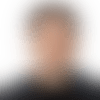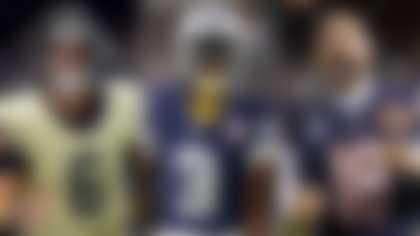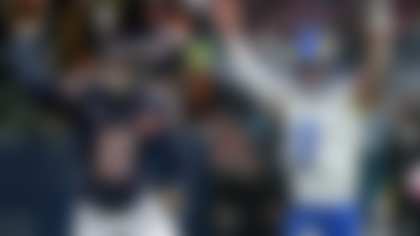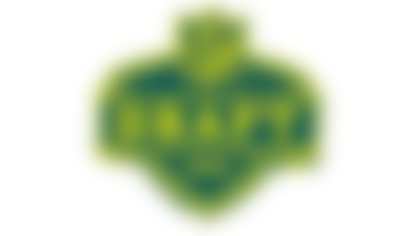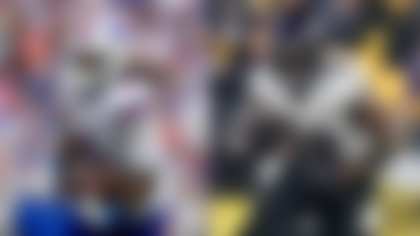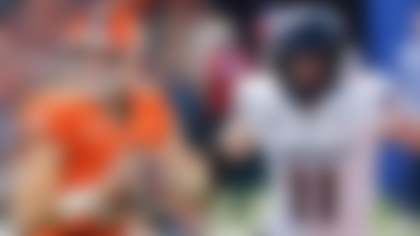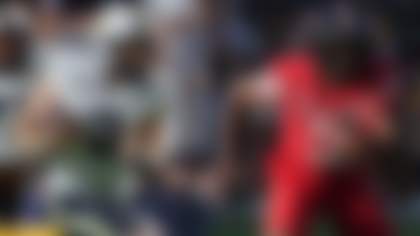With minicamps wrapping up offseason programs this week, Gregg Rosenthal takes a look at the biggest remaining weak spot for each NFC team heading toward the 2018 season.
Arizona Cardinals: Wide receivers
In a perfect world, Larry Fitzgerald would be transitioning into role-player status for his age-35 season, having averaged just 10.1 yards per catch over the last two years. In this all-too-surreal world we live in, Fitzgerald is easily the Cardinals' top receiver -- and the battle for No. 2 comes down to a second-round rookie (Christian Kirk), a journeyman (Brice Butler) and a second-year undrafted tight end (Ricky Seals-Jones). The time-honored Cardinals trouble spots -- like the offensive line and the other cornerback spot opposite Patrick Peterson -- have been surpassed.
Atlanta Falcons: The ghost of Kyle Shanahan
I love the Falcons' roster, aside from an offensive line that might top out as good, not great. There are no apparent huge weaknesses, and the defense as a whole is ready to fly. The biggest obstacle could be the memory of who's no longer in the building. Every slow offensive half by the Falcons is likely to inspire more unfavorable comparisons between offensive coordinator Steve Sarkisian and his predecessor. The 2016 Falcons' offense isn't coming back, but the team's playoff push last season showed this squad has other avenues to win games. Atlanta doesn't have to be record-breaking on offense to be right back in the title mix.
Carolina Panthers: Secondary
For years, the secondary was Carolina's secret sauce. The Panthers could throw a disparate group of players together and find success because of the system. After losing Josh Norman and two defensive coordinators in as many seasons, it's worth wondering if that formula will still work. The team is counting on journeyman Ross Cockrell, 37-year-old safety Mike Adams and career backup safety Colin Jones to all play major roles. The team could be leaning on the system too hard this time.
Chicago Bears: Offensive cohesion
The longer this offseason lasts, the more I like this Bears roster. It's sturdy throughout, with a strong base on both lines. The only trick is making this grand offensive overhaul work right out of the gate. The additions of Allen Robinson, Taylor Gabriel, Anthony Miller and Trey Burton look great on paper, but fitting all the new pieces together is a lot to ask of first-time head coach Matt Nagy and second-year quarterback Mitchell Trubisky.
Dallas Cowboys: Receiving weapons for Dak Prescott
Sometimes the easiest answer is the right one. Terrance Williams enters this season as the Cowboys wideout with the most career production, and it's not particularly close. In Williams, Allen Hurns, Cole Beasley and rookie Michael Gallup, Dallas has a collection of players who would be best utilized as No. 3 or No. 4 wideouts. After an offseason of empty chatter about creating a Dak-friendly offense, the Cowboys didn't find Dak enough friends.
Detroit Lions: Linebackers
Everyone in Detroit is tired of reading, writing or being asked about the running game. So let's give it a break and look at another area of concern. New Lions coach Matt Patricia relies on his linebacker unit as the backbone of his defense and showed it in free agency when the team signed two presumptive starters in Christian Jones and Devon Kennard. Giving them big roles is a projection, as is expecting greatness from last year's first-round pick, Jarrad Davis, after an up-and-down rookie season. This is a boom-or-bust group that could be the key to Patricia's first season.
Green Bay Packers: Experience in the secondary
The Packers lack many glaring issues if you look past the right side of the offensive line. (But I could list the right side of the OL for nearly every team, and even fewer people would read this.) When I pressed Packers defensive end Mike Daniels on Monday for a potential trouble spot on a defense he believes is among the league's most talented, he mentioned the youth of the secondary. New coordinator Mike Pettine will be counting a lot on Kevin King, Jaire Alexander, Josh Jones and Josh Jackson, all first- and second-round picks from the last two years. Daniels is confident they'll fit right in on a defense that is enjoying life with Pettine.
"It's never been like this since I've been here," Daniels said of the defense's dominance in OTAs.
Los Angeles Rams: Edge rushers
In Wade Phillips they trust. (And in Aaron Donald, Ndamukong Suh and Michael Brockers' ability to occupy blockers and free up linebackers to get to the quarterback nearly untouched.) On a roster loaded two deep at most positions, projected starting edge rushers Samson Ebukam and Matt Longacre are remarkably unproven.
Minnesota Vikings: Expectations
The Vikings were saddled with weighty expectations in 2016 and finished 8-8. Anything less than a Super Bowl appearance by Minnesota this time around will be viewed as a disappointment. That's a recipe for trouble in a loaded conference, with Aaron Rodgers' return to health in the division. Every year, a team (or two) that fell just short in the previous season's playoffs believes it's slightly better and appears poised to break through ... before collapsing under the weight of what should have been. Staying near the top is a lot tougher than getting there.
New Orleans Saints: Linebackers
Give Saints general manager Mickey Loomis credit for throwing as many darts as possible at this annual problem. Between Demario Davis, Alex Anzalone, A.J. Klein, Manti Te'o and Craig Robertson, the Saints should be able to field a workable trio to play between a sneaky-good Saints defensive line and a talented secondary.
New York Giants: Still the offensive line
Big-ticket left tackle Nate Solder and second-round guard Will Hernandez are obvious upgrades on paper. But it's worth noting Solder graded out as a top-30 tackle by Pro Football Focus only once in the last four years. And the rest of the line has major questions. The Giants are replacing their two best linemen (center Weston Richburg and guard Justin Pugh), while hoping blind-side bust Ereck Flowers can transition to right tackle.
Philadelphia Eagles: Health
Carson Wentz's rehabilitation will get most of the attention, but he's one of many Eagles on the mend. Wideout Alshon Jeffery is coming off a torn rotator cuff, while RB Darren Sproles is still working his way back on to the field after tearing his ACL and breaking his arm on the same play last September. Middle linebacker Jordan Hicks is coming off a torn Achilles tendon, and his return is more crucial than ever after the team lost reserve Paul Worrilow for the season to a torn ACL in OTAs. The team's best pass rusher, Brandon Graham, underwent ankle surgery in May, while starting defensive tackle Tim Jernigan could miss much of the season after having offseason back injury. Cornerback Sidney Jones is returning from his own Achilles injury. This is the best roster in football, but that's a lot of injury risk to be worried about before the pads even come on.
San Francisco 49ers: Secondary
The 49ers entered the draft with a major need at cornerback and surprisingly waited until Day 3 (D.J. Reed in Round 5) to address it. They believe in raw cover men Ahkello Witherspoon and K'Waun Williams, despite a pass defense that ranked among the league's worst last year. They are betting big on Richard Sherman looking like Richard Sherman again after Achilles surgery.
Seattle Seahawks: Pete's next-gen defense
Turning over the Seahawks' defense was inevitable -- and the changes might not be over this offseason, with the futures of safeties Earl Thomas and Kam Chancellor in doubt. Getting rid of veterans is the easy part, however. Developing the next crop of talent into true difference makers is where the challenge lies. Coach Pete Carroll needs new stars, with Frank Clark, Dion Jordan, Shaquill Griffin and Rasheem Green among the candidates.
Tampa Bay Buccaneers: Secondary
Bucs general manager Jason Licht knew the team's secondary was a problem, so he traded down to select two surprising cornerbacks (M.J. Stewart and Carlton Davis) in the second round of this year's draft. Their ability to make an immediate impact will be crucial for this defense, especially with both safety spots being up for grabs.
Washington Redskins: Defensive line
The Redskins' defense lacks true difference-makers on each level. This unit's a collection of fine players and former first-team All-Pro Josh Norman ... without many candidates to rise to transcendence. The defensive line stands out because it has struggled in recent years and contains Washington's last two first-round picks: Jonathan Allen and Daron Payne. The Redskins have invested plenty in this line through the draft and free agency and need it to start bringing results.
Follow Gregg Rosenthal on Twitter @greggrosenthal.
